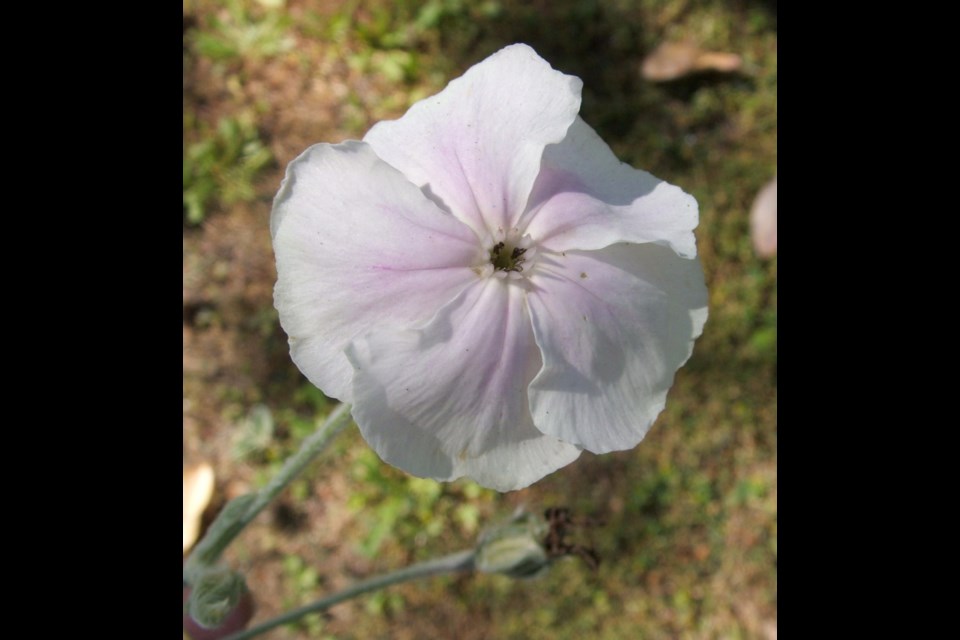As I was working in the front garden recently, people passing by stopped to ask about flowers blooming on the boulevard.
The plants were all self-sown variations of rose campion (Lychnis coronaria), a short-lived perennial that has produced new plants from seed every year, throughout the garden, ever since I planted a form called Angel’s Blush years ago.
The standard rose campion species is a familiar plant with dense clumps of velvety, silver-grey foliage and multi-branched stems bearing bright magenta-pink blooms. Like most species, L. coronaria doesn’t always produce flowers in a common, uniform colour. Seed growers over the years have selected certain variations and propagated them to produce a distinct strain.
Most of the flowers on my self-sown boulevard plants this year are white, some with vestiges of the pink blushing characteristic of my original Angel’s Blush seeding. One plant bears the usual deep magenta pink blooms of the species.
One man stopped his truck beside the boulevard and asked permission to photograph the white-flowered rose campion for his mother, a keen gardener. They’d never seen rose campion with white blooms.
The British company Chiltern Seeds lists the species, along with Angel’s Blush and Alba — the white-flowering form. J.L. Hudson (California) also lists Alba, as White Campion. Angel’s Blush is sometimes named L. coronaria Oculata.
Most mainstream catalogues no longer list this historic Mediterranean flower. Two more sources are Brother Nature Seeds in Victoria and Florabunda Seeds in Ontario.
Abundance. Until almost mid-month, cool temperatures and frequent rains created waves of lush green in our gardens. Everything grew profusely. I’ve never had such plump, juicy lettuces. The frilly endive has been flavourful, with no bitterness.
Potato tops grew uncommonly long. Spinach and beet greens were luxuriant. Cabbage family vegetables grew wonderfully robust in the cool weather. And the peas have been magic.
My first double row of peas, seeded mid-March, produced a mass of pods on thick-stemmed vines. A first picking, on July 1, yielded seven cups of blanched peas for the freezer. After a series of follow-up pickings I had frozen 25 cups of the peas. That did not include the ones I’d consumed fresh.
Now those vines are lifted, chopped and composted, and the second double, four-metre row has begun to yield filled pods. That first double row grew, like the second one, on wire fencing in a space one by four metres. The same space delivered around 10 lettuces that developed from transplants placed along the pea vine bases. That’s a fairly substantial yield of food from the limited space.
Along the south side of the same rectangular plot, another four-metre length of wire fencing supports a dozen staked tomato plants and two cucumber vines, with sweet potatoes growing in a strip on the south side of the tomatoes.
That space, four by 1.2 metres, promises a good yield of food if the weather warms sufficiently.
Delayed development. While cool growing plants flourished through late spring and early summer, others did not. Fruit set has been delayed on open garden tomatoes. Two of my three Sugar Baby watermelon transplants shivered into oblivion. The one remaining began expanding earlier in the month atop a partially “finished” compost heap, but it might be too late now for fruit set and ripening.
With warm, sunny weather, tomatoes should begin to develop fruits more normally, but varieties requiring a long, warm summer to ripen may prove disappointing this year. My Big Beef, Arbason and Japanese Trifele Black plants have swelling fruit.
There are plenty of small tomatoes on the potted patio varieties, though the plants have grown larger than they usually do. Fruits are developing on the potted miniature peppers.
The regular, full-sized cucumber plants have struggled, and bear only tiny fruits, but the two mini-cucumber varieties I’m growing have been more than gratifying.
I ate my first 13-centimetre cucumber from a Picolino (West Coast Seeds) vine on July 13 and the first from Green Light (T&T Seeds) the next day. The trained (upward) Green Light vines are as tall as I am. The vines are robust, with large, deep green leaves.
My friends had been raving about the greenhouse-grown mini-cucumbers sold at our local farmers’ market. Their comments prompted me to grow my own.



